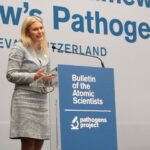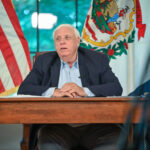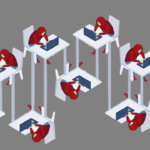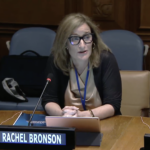Making the dual-use problem a “piece of cake”
By Malcolm Dando | July 9, 2008
Some academic conferences are encouraging because progress is being made in a field. Others are daunting because of the amount of work that clearly still needs to be done. The conference I attended in the beginning of June, on “Dual Uses of Biomedicine: Whose responsibility?” left me feeling both encouraged and daunted.
Over the last 10 years the Centre for Research Ethics & Bioethics at Uppsala University has organized an annual meeting on a topic related to biomedicine, ethics, and society. The topics have ranged from Genetics and Evolutionary Biology (1999), to Ethics at the Beginning of Life (2003), and to Imagining the Work of the Brain: Neuroethics (2005). This year an international group of 48 people gathered on Sandhamn Island off Stockholm for a concentrated two-day discussion of bioethics and the life sciences’ dual-use problem. According to the standard policy for these annual meetings, many of the participants were younger researchers, thus ensuring vigorous discussion both formally and informally. The meeting was also enlivened by some sparkling interventions from Emeritus Professor Carl-Göran Hedén who, being in his mid-nineties, was able to remind us of some of the debates about ethics and values that preceded the negotiation of the Biological and Toxin Weapons Convention of the late 1960s and early 1970s.
An internationally accepted code of conduct for biodefense workers might be combined with public national monitoring systems of biodefense to create enough transparency to reassure other states that biodefense programs are not involved in offensive activities.”
In one such intervention, Hedén referred to his 1968 Scientific World paper, which coalesced his thinking on scientific cooperation. Afterwards he kindly gave me a copy of the paper. In it he stated, “For certain areas of science, namely those where abuse seems likely, the emphasis on responsibility for human welfare might have to be stressed by a required adherence to certain ethical rules. . . .” He continued: “This consideration, based on my concern for the trends in biological weapons development . . . was actually the main reason why I started to speculate about the advantages of a formal co-ordination of the scientists in different countries.” The paper went on to describe a step-by-step approach that might have, but did not, produce such an ethically-based coordination scheme at that time.
The Sandhamn meeting was encouraging because of the progress being made today in practical implementation of mechanisms designed to deal with aspects of the dual-use problem. David Friedman, of the Institute for National Security Studies in Tel-Aviv, described the work of a committee set up in Israel to examine the dual-use problem. This committee, organized by the Israel National Security Council and the Israel Academy of Sciences and Humanities, suggested that a national system was required to oversee dual-use research in academic and commercial organizations and that this system should be based on the development of the local biosafety committee system.
What the committee’s report envisaged has similarities to what has been proposed by the U.S. National Science Advisory Board for Biosecurity. However, the Israeli system may prove to be a better model for smaller countries because of the strength of Israeli life science research, the speed with which the report has been produced, and the initial steps taken in implementing its recommendations.
At a different level of implementation, Peter Clevestig of the Stockholm Peace Research Institute described his work on a nearly completed Laboratory Biosecurity Handbook. Financed by the Swedish Emergency Management Agency, the handbook aims to raise awareness and provide appropriate procedures on biosecurity for people involved at all levels of work in laboratories. Similarly, Roger Roffey, of the Swedish Defence Research Agency, pointed out that biodefense activities are likely to cause dual-use misperceptions unless they are reasonably transparent to other countries and suggested how an internationally accepted code of conduct for biodefense workers might be combined with public national monitoring systems of biodefense to create enough transparency to reassure other states that biodefense programs are not involved in offensive activities.
The conference also addressed aspects of the dual-use problem that are not often discussed. Sita Ramchandra Kotnis, a PhD student from the Center of Functionally Integrative Neuroscience at the University of Aarhus in Denmark, gave a broad review of the ongoing military interest in modern neuroscience and of the potential for misuse of this research. In a geographical extension of the usual discussions of the dual-use problem, Michael Barr, a scholar from the Department of Geography, Politics, and Sociology at the University of Newcastle in Britain, reported on his extensive interviews with microbiologists and bioethicists in Beijing, Shanghai, and Guangzhou earlier this year. To those of us who have tried hard but failed to develop such contacts in China, this was quite fascinating and again encouraging in regard to possible follow-up visits and discussions.
The daunting nature of the task that lies ahead in dealing effectively with the dual-use problem in the life sciences–and particularly linking ethical analysis to practical activities–was nevertheless obvious from author and scholar Margaret Somerville’s plenary presentation, “Preventing the ‘Life Sciences’ from becoming the ‘Death Sciences’: Ethics, Law and Codes of Conduct in Dual-Use Research.” In part, Somerville, the founding director McGill Centre for Medicine, Ethics and Law, recalled her 2005 Science paper in which she and Ron Atlas proposed a code of conduct to counter bioterrorism. Somerville reiterated the ethical principles that should underlie work in the life science: “They include nonmalfeasance; beneficence; respect for life, especially human life; maintaining trust; embedding ethics in science; establishing a high ethical tone in institutions; acknowledging individual and collective responsibilities; . . . and the transmission of ethical values to colleagues and those we mentor.”
The list dauntingly illustrated the gap between where life scientists are and where we should be. And if it didn’t seem a tall enough order for practicing life sciences, Somerville alluded to other questions, such as “What should be the fiduciary responsibilities of experts in the life sciences to non-experts in our societies?” I was left wondering how many life scientists would even have heard of their fiduciary responsibilities.
This formidable plenary presentation ended on a brighter note, however, highlighting how ethical responsibilities are not like a football that can be passed along to others. Rather, ethical responsibilities are like slices of a cake: life scientists may only have a small role to play in the prevention of the misuse of their work, but it is their slice of the cake, and it is for them to take care of that slice. I liked that analogy and the implication that dealing with the dual-use problem will not place overwhelming demands on individual life scientists. Indeed, in my part of England to say that something is a “piece of cake” is to indicate that it is very easy to achieve–perhaps we should be less daunted and more encouraged by the progress we are making these days!
Together, we make the world safer.
The Bulletin elevates expert voices above the noise. But as an independent nonprofit organization, our operations depend on the support of readers like you. Help us continue to deliver quality journalism that holds leaders accountable. Your support of our work at any level is important. In return, we promise our coverage will be understandable, influential, vigilant, solution-oriented, and fair-minded. Together we can make a difference.
Topics: Biosecurity, Columnists















